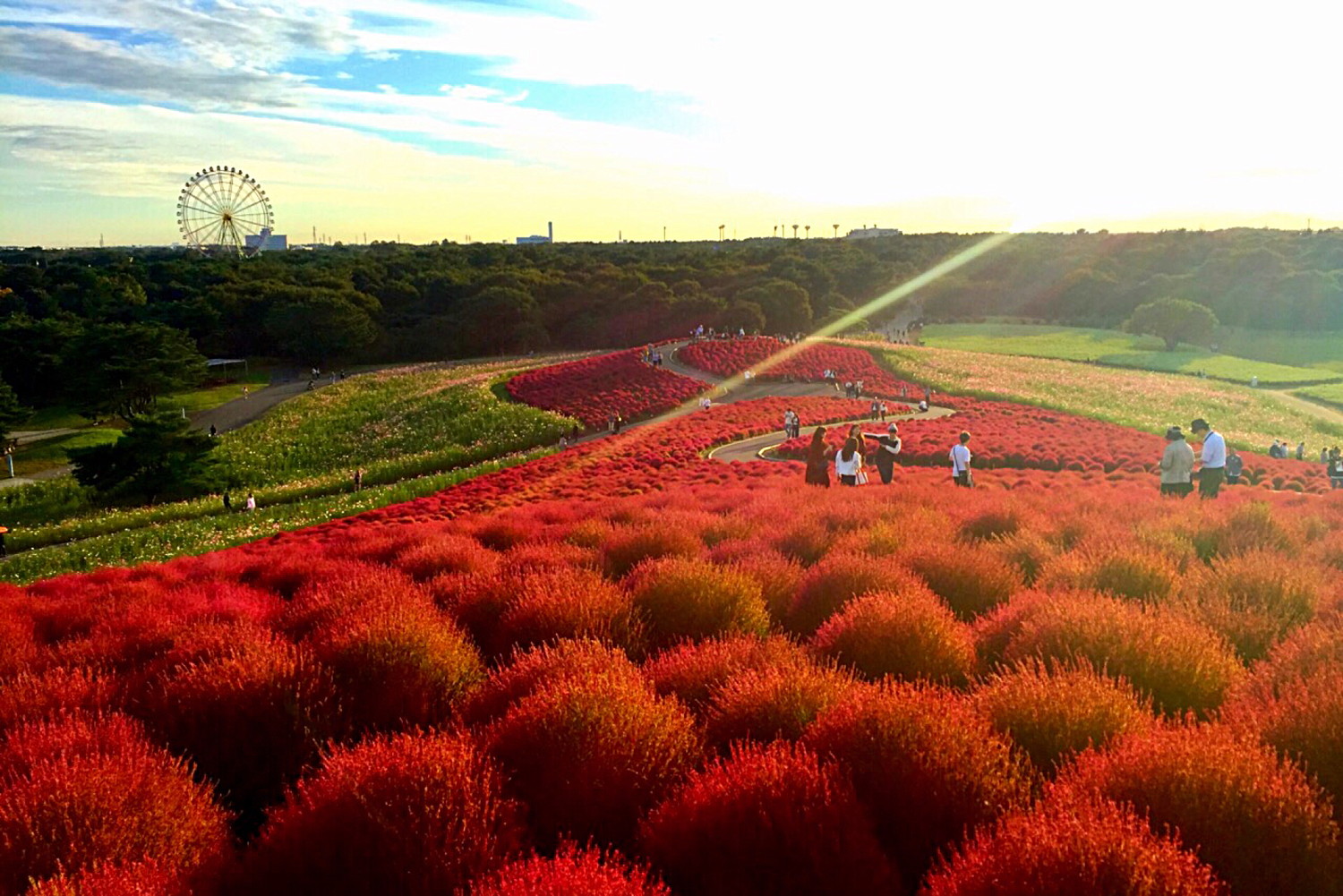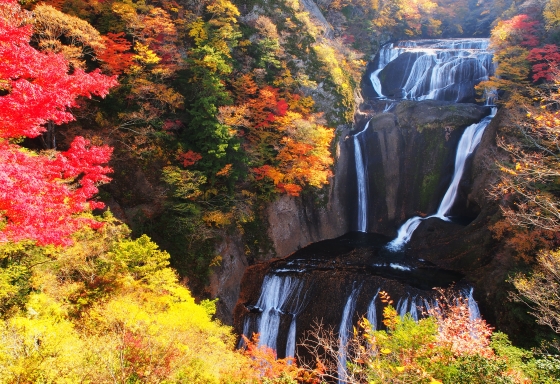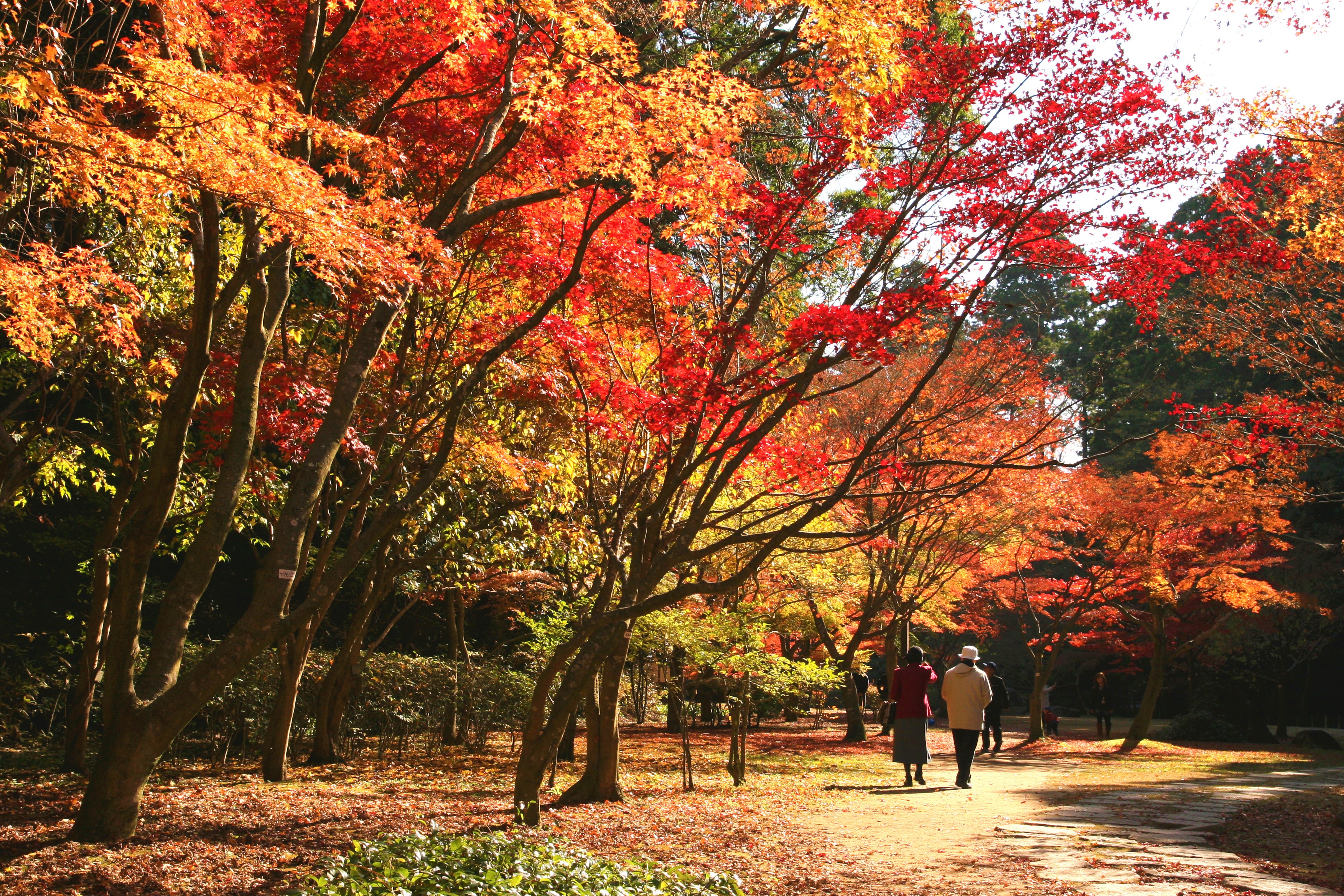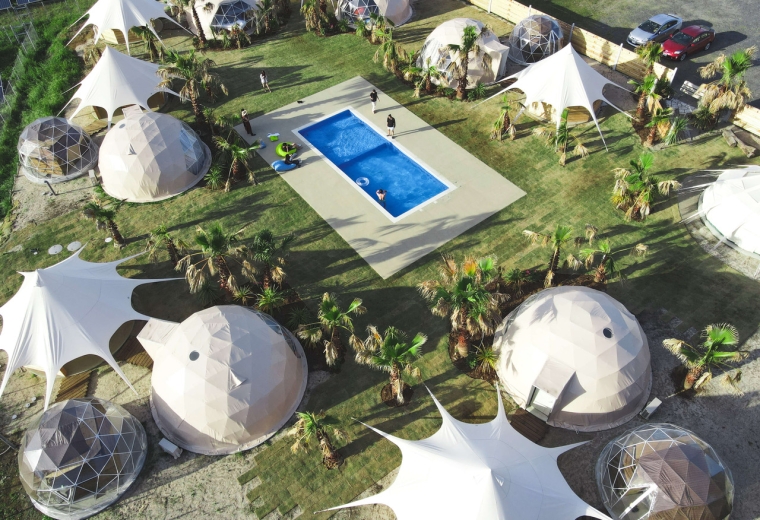Ibaraki’s Top 8 Fall Foliage Spots: Enjoy Splendid Views Near Tokyo
Nature
2023.10.06

Ibaraki Prefecture, accessible by day trip from Tokyo, is a famous destination for autumn foliage.
This article introduces eight splendid autumn foliage spots in Ibaraki―from popular attractions like Hitachi Seaside Park and Fukuroda Falls to Ryujin Suspension Bridge, where adventure seekers can experience a 100-meter-high bungee jump.
Excellent Access From Tokyo! Enjoy Autumn Foliage Amidst Ibaraki's Beautiful Nature
During the fall, the leaves of the trees turn red and yellow. Alongside the cherry blossoms, autumn foliage is one of the popular seasonal charms in Japan.
If you want to see the fall foliage, it’s best to enjoy it amidst beautiful natural surroundings—away from the hustle and bustle of the city. With that in mind, Ibaraki is easily accessible from Tokyo by day trip and offers many famous locations for autumn foliage.
This article introduces Ibaraki’s best locations to enjoy the autumn foliage.
While the peak season for viewing autumn foliage may vary depending on the specific location, generally speaking, November is the best time to see the leaves in the greater Tokyo area, including Ibaraki. Notably, on weekends and national holidays, these popular foliage spots tend to be quite crowded with Japanese visitors. To fully enjoy the beauty of the foliage in a relaxed atmosphere, we recommend visiting on a weekday.
Using the above map as a reference, find a spot that’s easily accessible for you!
1. Ryujin Suspension Bridge (Northern Ibaraki)

The Ryujin Gorge is a deep, V-shaped valley located in the Okukuji Prefectural Natural Park. Ryujin means Dragon God in the Japanese language. At the origin of this name is a legend about a pair of dragons that lived here in ancient times. Also, when seen from above, the river winds through the gorge in a dragon-shaped-like manner.
The Ryujin Suspension Bridge extends 375 meters between the two towers at its opposite ends. It’s the third-longest pedestrian-only bridge in Japan.
In November, the Ryujin Gorge and the surrounding mountains are beautifully dyed in bright red and yellow hues. The spectacular scenery created by the autumn leaves, gorge, and bridge can be enjoyed from various places. One of the best vantage points is the terrace at Ryujin Cafe, built on a steep cliff in the gorge.
The Ryujin Suspension Bridge is also famous for thrill-seekers to enjoy a 100-meter bungee jump (the second highest in Japan). When you attempt this challenge during autumn, the feeling is akin to diving among colorful autumn leaves. Visitors can also ride a canoe or boat while gazing at the gorge’s stunning autumn foliage and small waterfalls.
Autumn foliage season is also the perfect time to enjoy a regional specialty known as Hitachi Aki Soba, a traditional buckwheat noodle dish. You can try it at local restaurants in the town of Ryujin Gorge, Hitachiota City.
Information

Ryujin Suspension Bridge
Ryujin Suspension Bridge stands 100 meters above the Ryujin Dam Reservoir. Spanning 375 meters, the bridge is inspired by the legend of a dragon said to reside in the Ryujin River. It offers panorami…
See More2. See Kochia at Hitachi Seaside Park (Central Ibaraki)

In the Tokyo area, the kaede maple trees, momiji maple trees, and ginkgo trees―famous for their beautiful fall foliage―change color in November. However, people who can’t visit Japan in November don’t need to worry! In October, you can already enjoy the fall foliage in Ibaraki.
Hitachi Seaside Park is well known as a spectacular spot for viewing the blue Nemophila flowers in the spring. It’s also a unique fall foliage destination. Red kochia bushes, highlighting autumn at Hitachi Seaside Park, begin changing color in early October and are at their peak in mid-October. They take on a golden hue in late October, making it especially feel like autumn.
The kochia has a refreshing green color in the summer, pleasing the eye. However, the red kochia covering the hillside like a carpet during fall is genuinely breathtaking. If you can’t visit Japan in November, why not visit the kochia in October?
The shops and dining facilities within Hitachi Seaside Park offer kochia-inspired sweets during this time of the year. These desserts are truly worthy of sharing on social media!
Information

Hitachi Seaside Park
Hitachi Seaside Park is perhaps Ibaraki's most famous tourist destination for its Instagram-friendly fields of flowers. This vast park is best known for the stunning blue nemophila flowers in spring …
See More3. Fukuroda Falls (Northern Ibaraki)

Fukuroda Falls, located in Daigo Town, is a popular tourist attraction in Ibaraki. Along with Nikko’s Kegon Falls, it’s ranked as one of Japan’s Three Great Waterfalls.
The waterfall is quite impressive – it’s 120 meters tall and 73 meters wide. It is also known as “Yodo Falls” due to the water cascading down a rock face that has four tiers.
Fukuroda Falls is surrounded by kaede maple trees and Japanese chestnut oak trees (kunugi). From early to mid-November, the area is colored by bright red and yellow hues. A variety of waterfall scenes can be enjoyed from Observatory One and Observatory Two, the latter of which has three viewing decks. The suspension bridge located beneath the falls also offers an impressive view.
Before, during, and after the autumn foliage season there are other noteworthy highlights such as the waterfall evening illumination and the tunnel leading up to the falls, lit up and beautifully decorated.
Information

Fukuroda Falls
Fukuroda Falls is ranked among Japan’s "Three Great Waterfalls." A visit here will quickly reveal why. Water cascades over four levels of the rocky cliff face, earning it the nickname "Yodo no Taki" …
See More4. Eigenji Temple: Known as Momiji-dera (Northern Ibaraki)

In addition to Fukuroda Falls, Eigenji Temple is also known as an autumn foliage destination in Daigo.
Eigenji, originally built in 1446, is located near Hitachi-Daigo Station. The temple is dedicated to Benzaiten, the goddess of the arts and one of the Seven Deities of Good Fortune.
About 25 years ago at Eigenji Temple, local residents and temple members began planting kaede maple trees in an effort to maintain the precincts. Every year since then, from early to mid-November, the temple precincts are filled with red and yellow leaves. As a result, the temple came to be called “Momiji-dera,” or the “Autumn Foliage Temple.”
Throughout the temple grounds, you can take stunning photos of the impressive fall foliage, together with Buddhist statues, pagodas, and temple halls.
In addition to Fukuroda Falls and Eigenji Temple, Daigo has a variety of other locations for enjoying the autumn foliage. These include Tsukimachi Falls, which allows visitors to view the falls from behind, Kotokuji Temple with its beautiful ginkgo trees, and mts. Nantai and Yamizo, which offer scenic hiking trails amid the autumn splendor. So please be sure to take in all these sights during your trip.
Information

Eigenji Temple (Momiji Temple)
Eigenji Temple was constructed in 1446 and enshrines Benzaiten, the goddess of performing arts and one of the Seven Lucky Gods in Japan. It is also known as Momiji Temple due to the beautiful maple l…
See More5. Hananuki Gorge (Northern Ibaraki)

Hananuki Gorge is a well-known autumn foliage destination, about 40 minutes drive from Fukuroda Falls.
The gorge presents the photogenic 60-meter-long Shiomi Falls Suspension Bridge. The Ryujin Suspension Bridge―mentioned earlier in this article―is attractive because of the spectacular sight in which the bridge appears to be floating in the mountains. In comparison, the Shiomi Falls Suspension Bridge is smaller, but visitors can enjoy a view in which the bridge itself looks as though it’s covered in autumn leaves.
In this local area, the Hananuki Dam→Namerigafuchi→Hananuki Gorge→ Kotakizawa Campsite route is connected by a walking path. In the fall season, you can enjoy hiking while surrounded by colorful autumn leaves and beautiful natural scenery. Additionally, in the Hananuki Gorge area, there are short and comfortable walking routes for light hiking.
During the autumn foliage season from mid-November until late November, the area is illuminated at night, and there’s also the Hananuki Gorge Autumn Foliage Festival featuring various food kiosks lined up in the nearby parking lot.
Information

Hananuki Gorge
This scenic gorge area stretches from the Hananuki Dam to the Kotakizawa Camp Site. The gorge's most famous attraction is the stunning Shiomi Falls Suspension Bridge. There are also plenty of hiking…
See More6. Mt. Tsukuba (Southern Ibaraki)

Mt. Tsukuba is one of the most popular sightseeing spots in Ibaraki. Visitors can enjoy more than 1,000 different species of plant life throughout the year, and also admire the changing colors of the ginkgo and momiji maple tree leaves.
You also don’t want to miss the amazing views from the mountain’s ropeway and cable car, in particular during the Mt. Tsukuba Momiji Festival, from the end of October until early December. During the festival the autumn foliage near the cable car’s Miyawaki Station is lit up, with the cable car offering a special evening service called “Night Cruising” on Saturdays, Sundays, and national holidays. In the third week of November―considered to be the best time for seeing the fall foliage ーthese events are held every day.
In addition, the ropeway’s “Stardust Cruising” event is also highly popular. This event is held on Saturdays, Sundays, and public holidays during autumn and winter, giving visitors unforgettable night views from Mt. Tsukuba.
We also recommend visiting Mt. Tsukuba’s Tsukubasan Shrine. During the autumn foliage season, the ginkgo trees on the shrine precincts turn a beautiful yellow color. Near the shrine, there are several hot springs that can even be enjoyed on day trips, so travelers can take respite and rejuvenate their weary selves.
Information

Mount Tsukuba
The twin peaks of Mount Tsukuba are symbolic of Ibaraki. In Japanese, the peaks are Nyotai and Nantai, meaning the female peak and male peak, respectively. At 877 meters tall, Nyotai, the female peak…
See More7. Kairakuen Garden: Momiji Valley (Central Ibaraki)

Kairakuen Garden, located in Mito, Ibaraki’s prefectural capital, is famous for being one of the Three Great Gardens of Japan. Visitors can enjoy looking at many varieties of plants in the garden, plum trees and their blossoms being one of the major highlights.
Momiji Valley (Momiji-dani) is an area on the west side of Kairakuen Garden. During the fall season, the foliage of about 170 kaede and momiji maple trees changes into many beautiful colors. From early to mid-November the area gets illuminated at night, and the ensuing magical scenery spreads out right in front of visitors.
You can also enjoy the sight of cherry tree leaves changing into their brilliant fall colors from the promenade that surrounds Kairakuen Garden’s neighboring Lake Senba. We highly recommend going for a leisurely stroll here.
Information

Kairakuen Garden
Kairakuen Garden is ranked among Japan’s top three most beautiful gardens, alongside Kenrokuen in Kanazawa and Korakuen in Okayama. The garden was established in 1842 by Nariaki Tokugawa, the ninth f…
See More8. Ibaraki Prefectural Archives and History Museum (Central Ibaraki)

Japan has numerous fall foliage destinations, offering visitors a chance to witness the stunning red and yellow colors of kaede and momiji maple trees. Additionally, there are several popular spots with rows of ginkgo trees that turn yellow during autumn. Some of these locations also offer evening illuminations that further enhance the beauty of the trees. One such spot is the Ibaraki Prefectural Archives and History Museum.
The Ibaraki Prefectural Archives and History Museum is home to several historic buildings such as the former Mizukaido Elementary School main building that was constructed in 1881, and also the former Mogi Family Residence, believed to have been built in the first half of the 18th century. Kairakuen Garden is also close by, so you can see both attractions on the same day.
On the museum site there is a row of gingko trees extending for about 100 meters. The best time to take in the fall scenery is from early to mid-November when the fallen leaves form an exquisite golden carpet over the entire area.
Along with the nighttime illuminations taking place at this time of the year, visitors can enjoy decorations with traditional Japanese lanterns as well as projection mapping.
Information

Ibaraki Prefectural Archives and History Museum
The Ibaraki Prefectural Archives and History Museum (Mito City) was established in 1974. Permanent exhibits showcase the history of Ibaraki from ancient times to the present day. The museum itself is…
See MoreHead to Ibaraki to Enjoy Autumn Foliage and Tasty Cuisine
During the fall season in Japan, you can enjoy more than just the beautiful autumn leaves. Ibaraki is renowned for its exquisite seasonal delicacies such as Hitachi-Aki soba, hoshi-imo (dried sweet potatoes), chestnuts, persimmons, pears, apples, and an array of fruits. You have the opportunity to indulge in these delectable treats that are a feast for both your eyes and taste buds.
Check out the links below if you’re interested in topics related to this article.






